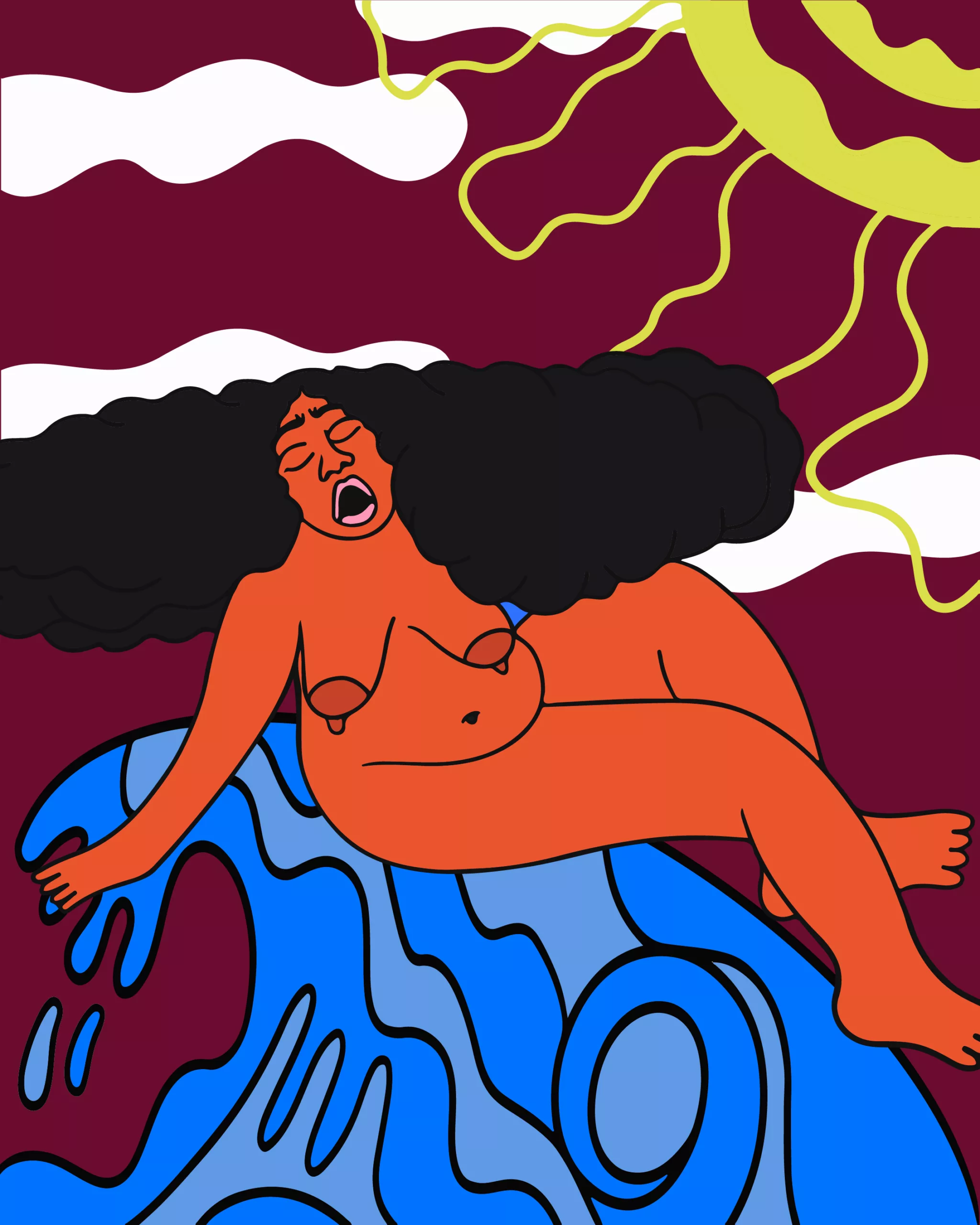Your cart is currently empty!

I’m Not Like Other Girls: Internalized Misogyny
At the age of twelve, my friend Puberty showed up in my life. Uninvited, like a parasite. Little by little, I became aware of the changes it was causing in my body. Unwelcome, undesirable. My new chest and hips brought me to the brutal realization that I was no longer a child and that others would now perceive me as a woman… along with everything that implied.
At thirteen, I started wearing gray, baggy, masculine clothes: clothes that didn’t invite too much attention and in which I felt I could breathe. My dad’s blue sweater. Loose jeans, sometimes picked out from the men’s clothing section. I had my hair cut very short, not because I liked the cut per se, but because it made me look boyish. Gradually and subtly, I changed the timbre of my voice, making it slightly deeper than it actually was.
On the surface, investing such efforts in a more masculine gender expression may simply reflect personal tastes and preferences, and therefore seem harmless, positive, even. After all, several studies show that social gender affirmation, which can be accomplished by adopting a gender expression that conforms to one’s gender identity, is associated with better mental health in trans people (King & Gamarel, 2021).
The thing is, I’m not trans.
In my case, the desire to appear masculine reflected a major problem: I was deeply ashamed of being a woman and I sought to dissociate myself from femininity at all costs. In my eyes, if being a girl was already bad enough, being a woman was much worse.
And this shame didn’t come out of nowhere.
Where are feminized persons in the media?
Looking back, I see that part of the problem was that feminized people are relatively underrepresented in the media. According to Women and Hollywood, women made up 33% of all characters in the 100 highest-grossing films of 2011 and only 11% of protagonists. In 2019, these statistics remained unchanged. You read that right. On the big screen, there are approximately twice as many men as women.
The under-representation of women in the media led to the creation of the Bechdel test in 1985, which aims to roughly measure the representation of female characters in a work of fiction. For a work to pass this test, it must:
- contain at least two named female characters
- who talk to each other
- about something other than a man!
Simple enough? Think again. According to an analysis of 1,794 movies released between 1990 and 2013, only 53% meet the Bechdel test criteria (Hickey, 2014).
When so many movies fail the Bechdel test and portray feminized people unidimensionally or stereotypically, it’s no wonder that many girls, including yours truly, more often identify with male characters, especially when their femininity does not conform to the one that is being sold to them. Growing up, let’s just say that it was way more fun pretending to be Peter Pan than Wendy or Tinker Bell, (who doesn’t even speak!).
Female characters, one-dimensional beings
Other than being under-represented in the media, feminized people also tend to be portrayed in a simple, stereotypical, and homogeneous way.
In terms of physical appearance, young women are overrepresented: 70% of female characters in the 100 highest-grossing films of 2019 were under the age of 40 (Women and Hollywood, 2019). And let’s face it, these women are also mostly pretty, white, and thin. It’s the same thing in animation, especially Pixar, where women’s physiques, especially their faces, are relatively standardized, the female characters blending in with one another.
In terms of personal interests, female characters are typically preoccupied with love, dating, and marriage, and enjoy makeup, shoes, and shopping. In addition, several female prototypes, including the damsel in distress, Miss Fanservice, the gold digger, the sexy secretary, the ditz, and the femme fatale, are also common in the media (Gala et al., 2020), and none of them paints a particularly positive portrait of feminized people.
As the names of many of these prototypes suggest, feminized people are also often eroticized, sexualized, or objectified in the media.
Growing up, I was bombarded with an abundance of bare flesh, revealing and suggestive clothing, and sexualized feminized bodies, which were often portrayed as both enviable and desirable and as worthy of judgment and contempt. I saw too few depictions of feminized people that alluded to their intelligence, creativity, dreams, ambitions, and varied talents and interests. In short, my eyes and head were filled with erotic representations devoid of human complexity.
Consequently, I had the impression that women were mainly valued (and despised) for their sex appeal, which was mainly evaluated according to the male gaze and male desire. Of course, there’s absolutely nothing wrong with sexuality, but when it’s presented as the sole or main facet of a person, it’s ordinary at best, and dehumanizing at worst.
Femininity: what a shame!
Femininity and feminized people are also often denigrated. For example, two sitcoms I enjoyed watching when I was 13, Third Rock from the Sun and Friends, are full of sexist jokes and comments. (Ok, I still watch them once in a while. It’s my guilty pleasure! 😉)
That said, the problem is not just in the media. Through culture, everyday conversations, and jokes told by dodgy uncles, I was also exposed to a ton of messages suggesting—affirming—that femininity, and by extension feminized people, weren’t worth much.
Hearing a thousand variations of “you __ like a girl”. Becoming aware that “feminine” clothes on a “masculine” body provoke laughter, while no one bats an eye when they see “masculine” clothes on a feminized person. Hearing in passing that women are less funny and less intelligent than men. That they are irrational, frivolous, and crazy, and therefore not to be taken seriously. That they are liars and manipulators, and therefore, arouse mistrust. Understanding that many people perceive cisgender women as “naturally” sensitive, weak, and vulnerable creatures: a belief that is often used by many men as a reason to “protect”, restrict, or control them. And so on.
Why is the under-representation (and misrepresentation) of feminized people problematic?
Since cisgender men have no direct experience of life as a woman, they rely, consciously or unconsciously, on representations of women to better “understand” them. As I explained above, the problem is that these representations are on average stereotyped and unrepresentative. Because women are also exposed to the same narrow set of female role models, many of them, especially younger women, can be misled into believing that they represent “most” girls and women. Many women whose femininity deviates from “the” femininity therefore see themselves as different or as “exceptions” to the “norm”.
Because I loved playing video games, climbing trees, and riding my bike, I didn’t think I was like “most” girls. Because I rode a motorcycle, loved playing pool, and didn’t care about marriage, I didn’t think I was like “most” women.
And also, because I perceived that “most” girls and women were weak, superficial, and irrational, I often said loudly and proudly, from my teens to my early twenties, “I’m not like most girls.” And when I said those words, what rang in my head was, “I’m better than most girls.”
If this doesn’t scream internalized misogyny, I don’t know what does.
Finding a healthy relationship with my gender
When I was younger, I didn’t want to confirm my “inferior” status by accepting my more “feminine” side, nor to be penalized because of my femininity. I didn’t want to be judged primarily on my appearance. I didn’t want my value to be reduced to my sexuality. I wanted people to listen to me when I spoke. I wanted my ideas and knowledge to matter and be taken seriously.
I wanted people to see me—my complexity, my humanity—and not define me by my gender and its stereotypes.
Because I couldn’t change other people’s perceptions and society’s view of femininity, getting rid of my gender malaise was a long and arduous process. But I succeeded. I slowly but surely learned to distinguish between what people believe and think about feminized people and their realities, thereby not letting the gaze or judgments of others define me. For example, thinking that I have no respect for myself or for others because I don’t wear a bra in public says a lot more about the person with that opinion than it does about me.
I also started flipping all popular gender beliefs onto their heads. If a belief that is commonly applied to feminized people seems strange or ridiculous when applied to men, then it’s a double standard, and therefore, good only for the trash can.
Challenging these cultural beliefs has also led me to take a more critical look at gender in general, which has proven to be extremely liberating. Why, for example, are dresses, the colour pink, and long hair associated with femininity but not masculinity? But also, why are so-called masculine things so highly valued in our society? By reading several books, I not only learned that what we consider to be feminine or masculine changes throughout history, but also that several “facts” about gender are downright incorrect. I’ve come to the conclusion that the cultural vision of gender is largely arbitrary: an observation that has helped me greatly to embrace my gender, regardless of its expression.
Lastly, for those who need to hear it: there is absolutely nothing shameful about femininity or being a woman. Full-stop. Femininity is as valuable as the rest. It took me a long time to recognize it, but… better late than never. 💗
-
Gala, D., Khursheed, M. O., Lerner, H., O’Connor, B., & Iyyer, M. (2020). Analyzing gender bias within narrative tropes. arXiv:2011.00092v1
Hickey, W. (2014, April 1). The dollar-and-cents case against Hollywood’s exclusion of women. FiveThirtyEight. https://fivethirtyeight.com/features/the-dollar-and-cents-case-against-hollywoods-exclusion-of-women/
King, W. M. & Gamarel, K. E. (2021). A scoping review examining social and legal gender affirmation and health among transgender populations. Transgender Health, 6(1), 5–22. https://doi.org/10.1089/trgh.2020.0025
Women and Hollywood. (2011). 2011 Statistics. https://womenandhollywood.com/resources/statistics/2011-statistics/
Women and Hollywood. (2019). 2019 Statistics. https://womenandhollywood.com/resources/statistics/2019-statistics/





